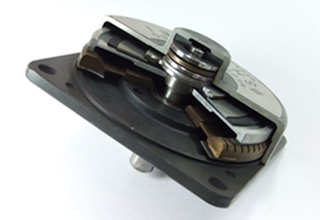Ultrasonic piezo motors harness oscillations induced in a piezoelectric material to produce motion, which can be either rotary or linear. Their design and operation are relatively simple but allows them to achieve very high accelerations and speeds, and to produce high holding forces when no current is applied.
Construction and operation

Image credit: Shinsei Corporation
For rotary motion, the piezo motor is composed of a stator that incorporates piezoelectric materials, a friction component, and a rotor. When a voltage is applied to the stator, the piezoelectric material is excited and produces ultrasonic vibrations in the stator. The rotor is pressed against the stator, with the friction material between them, and rotation is induced in the rotor by the interaction of these surfaces.
The vibrations in the stator form a wave of motion, and only the peaks of the wave make contact with the rotor. As the wave progresses, the rotor travels in the opposite direction of the wave’s motion.

Image credit: Physik Instrumente GmbH
For linear motion, a piezoelectric plate replaces the traditional stator. When a voltage is applied, the plate is excited at its resonance frequency, which causes it to oscillate. A coupling, or “pusher,” is attached to the plate, and the plate’s oscillations cause the pusher to move along an inclined path at the same frequency. The pusher is in contact with a slider and causes it to move linearly.

Image credit: The Physics Classroom
Ultrasonic piezo motors are sometimes called “standing wave piezo motors,” due to the type of wave generated when the piezoelectric material is excited. A standing wave is formed when an incident (original) and a reflected wave interfere in such a way that there are points along the medium that appear to not be moving, or to be standing still. Hence, the name, “standing wave.”
Performance characteristics
Ultrasonic piezo motors are direct drive mechanisms, meaning they have no mechanical couplings or gears to induce backlash. However, their reliance on friction between the stator and the rotor (or between the pusher and the slider, in the case of a linear motor), limits their resolution to 50 – 80 nm. This friction does offer an advantage, though, in the form of a holding force when no power is applied.
The working principle of ultrasonic piezo motors, coupled with their low inertia, give them very fast response times, with maximum velocities up to 500 mm/s (600 – 800 deg/s for rotary motion) and accelerations of 10 to 20 g. Ultrasonic piezo motors are inherently vacuum compatible, and because there are no magnetic components, they can be used in environments with strong magnetic fields.
Ultrasonic piezo motor applications
The most common application for ultrasonic piezo motors is the autofocus mechanism found in cameras, but high-precision imaging and scanning equipment of all kinds, including surveying and metrology devices, benefit from their speed and resolution. Other applications include military and aerospace equipment—especially the positioning of antennae or fine control of guidance systems. In the medical industry, ultrasonic piezo motors are used in life sciences equipment for nanoliter pumps, dispensing, and dosing, and in medical devices for control and positioning of imaging equipment.
For a good visual on the operation of both linear and rotary ultrasonic piezo motors, check out the video below from PI (Physik Instrumente).







Leave a Reply
You must be logged in to post a comment.